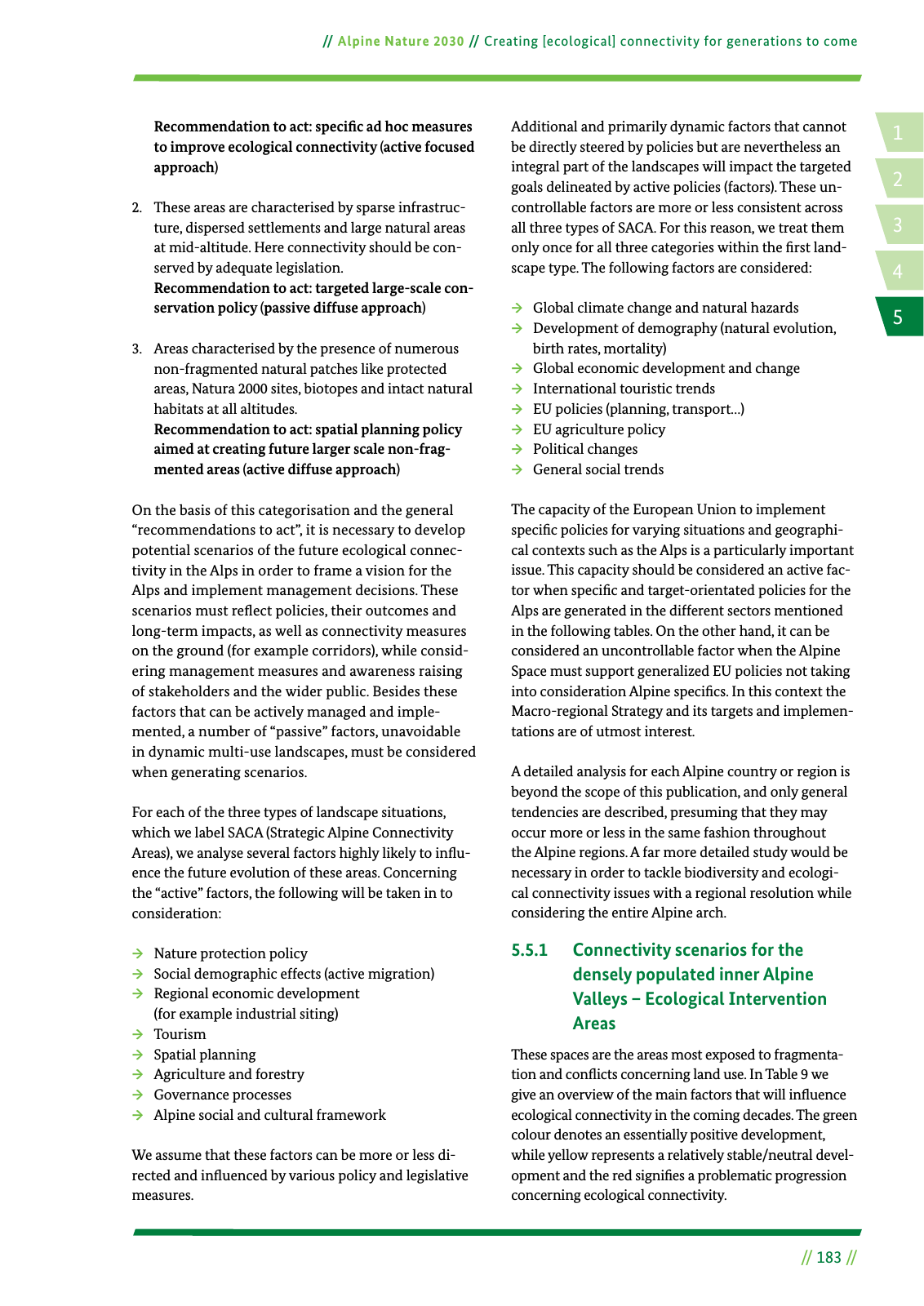14 2 5 3 Alpine Nature 2030 Creating ecological connectivity for generations to come 183 Recommendation to act speci c ad hoc measures to improve ecological connectivity active focused approach 2 These areas are characterised by sparse infrastruc ture dispersed settlements and large natural areas at mid altitude Here connectivity should be con served by adequate legislation Recommendation to act targeted large scale con servation policy passive diffuse approach 3 Areas characterised by the presence of numerous non fragmented natural patches like protected areas Natura 2000 sites biotopes and intact natural habitats at all altitudes Recommendation to act spatial planning policy aimed at creating future larger scale non frag mented areas active diffuse approach On the basis of this categorisation and the general recommendations to act it is necessary to develop potential scenarios of the future ecological connec tivity in the Alps in order to frame a vision for the Alps and implement management decisions These scenarios must re ect policies their outcomes and long term impacts as well as connectivity measures on the ground for example corridors while consid ering management measures and awareness raising of stakeholders and the wider public Besides these factors that can be actively managed and imple mented a number of passive factors unavoidable in dynamic multi use landscapes must be considered when generating scenarios For each of the three types of landscape situations which we label SACA Strategic Alpine Connectivity Areas we analyse several factors highly likely to in u ence the future evolution of these areas Concerning the active factors the following will be taken in to consideration Nature protection policy Social demographic effects active migration Regional economic development for example industrial siting Tourism Spatial planning Agriculture and forestry Governance processes Alpine social and cultural framework We assume that these factors can be more or less di rected and in uenced by various policy and legislative measures Additional and primarily dynamic factors that cannot be directly steered by policies but are nevertheless an integral part of the landscapes will impact the targeted goals delineated by active policies factors These un controllable factors are more or less consistent across all three types of SACA For this reason we treat them only once for all three categories within the rst land scape type The following factors are considered Global climate change and natural hazards Development of demography natural evolution birth rates mortality Global economic development and change International touristic trends EU policies planning transport EU agriculture policy Political changes General social trends The capacity of the European Union to implement speci c policies for varying situations and geographi cal contexts such as the Alps is a particularly important issue This capacity should be considered an active fac tor when speci c and target orientated policies for the Alps are generated in the different sectors mentioned in the following tables On the other hand it can be considered an uncontrollable factor when the Alpine Space must support generalized EU policies not taking into consideration Alpine speci cs In this context the Macro regional Strategy and its targets and implemen tations are of utmost interest A detailed analysis for each Alpine country or region is beyond the scope of this publication and only general tendencies are described presuming that they may occur more or less in the same fashion throughout the Alpine regions A far more detailed study would be necessary in order to tackle biodiversity and ecologi cal connectivity issues with a regional resolution while considering the entire Alpine arch 5 5 1 Connectivity scenarios for the densely populated inner Alpine Valleys Ecological Intervention Areas These spaces are the areas most exposed to fragmenta tion and con icts concerning land use In Table 9 we give an overview of the main factors that will in uence ecological connectivity in the coming decades The green colour denotes an essentially positive development while yellow represents a relatively stable neutral devel opment and the red signi es a problematic progression concerning ecological connectivity

Hinweis: Dies ist eine maschinenlesbare No-Flash Ansicht.
Klicken Sie hier um zur Online-Version zu gelangen.
Klicken Sie hier um zur Online-Version zu gelangen.